Abstract
STUDY OBJECTIVE--The aim was to analyse occupational mortality differences among women using follow up data from a large nationally representative sample. DESIGN--Occupational information was obtained from the 1971 census records of women in the Longitudinal Study carried out by the Office of Population Censuses and Surveys (OPCS) and related to their subsequent mortality in the period between the 1971 and 1981 censuses. SETTING--In the Longitudinal Study, census, vital statistics, and other OPCS records are linked for a 1% sample of the population of England and Wales. The women studied in this paper were drawn from the 513,071 persons in the 1971 census who were included in the Longitudinal Study and whose entries were traced at the National Health Service Central Register by 1977. PARTICIPANTS--The analysis was based on 77,081 women aged 15-59 years in the Longitudinal Study for whom occupational information was collected in the 1971 census (99% of whom were in paid employment in the week before the census). There were 1553 deaths among these women in the follow up period analysed here. MEASUREMENTS AND MAIN RESULTS--Numbers of deaths in each occupational group at census were compared to those expected on the basis of age specific death rates among all women in the study. "Professional, technical workers, and artists" had significantly low mortality while "Engineering and allied trades workers nec" had significantly high mortality. Among the latter, cancer mortality of electrical production process workers was extremely high. A number of other cause specific associations (which appear to confirm proportionate Decennial Supplement analyses) were suggested by the data; examples include high levels of mortality from ischaemic heart disease among cooks, lung cancer and respiratory disease among charwomen and cleaners, and accidents, poisonings, and violence among several groups of professional and technical workers. CONCLUSIONS--By using prospective follow up from the census, occupational differences in mortality can be identified among women in paid employment. As follow up of this study continues, numbers of deaths available for analysis will increase, allowing increasingly comprehensive analyses to be undertaken.
Full text
PDF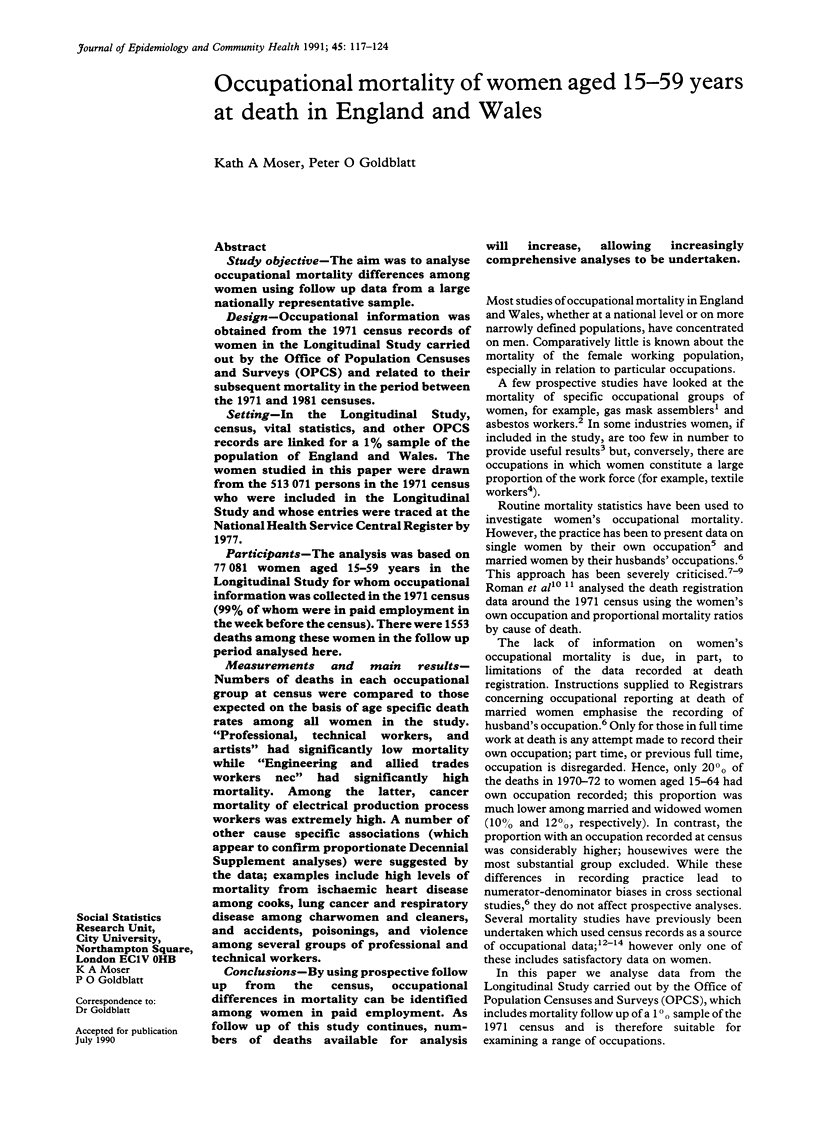
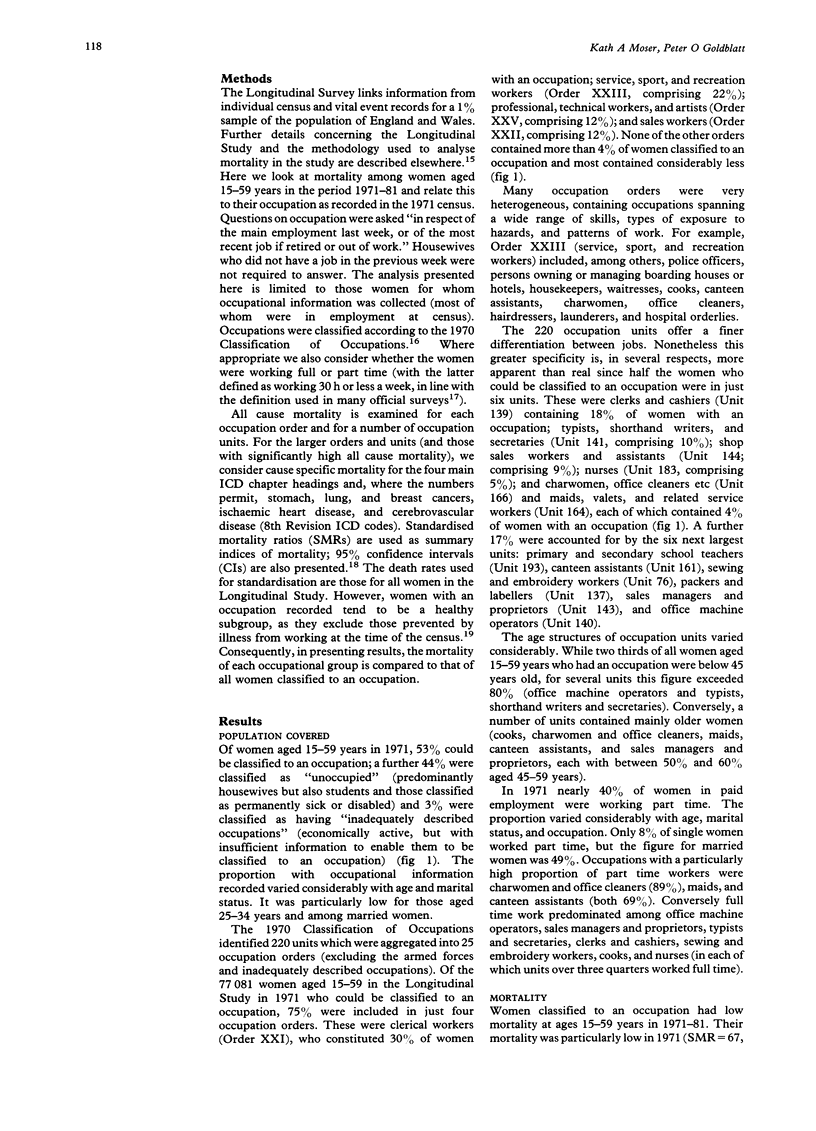
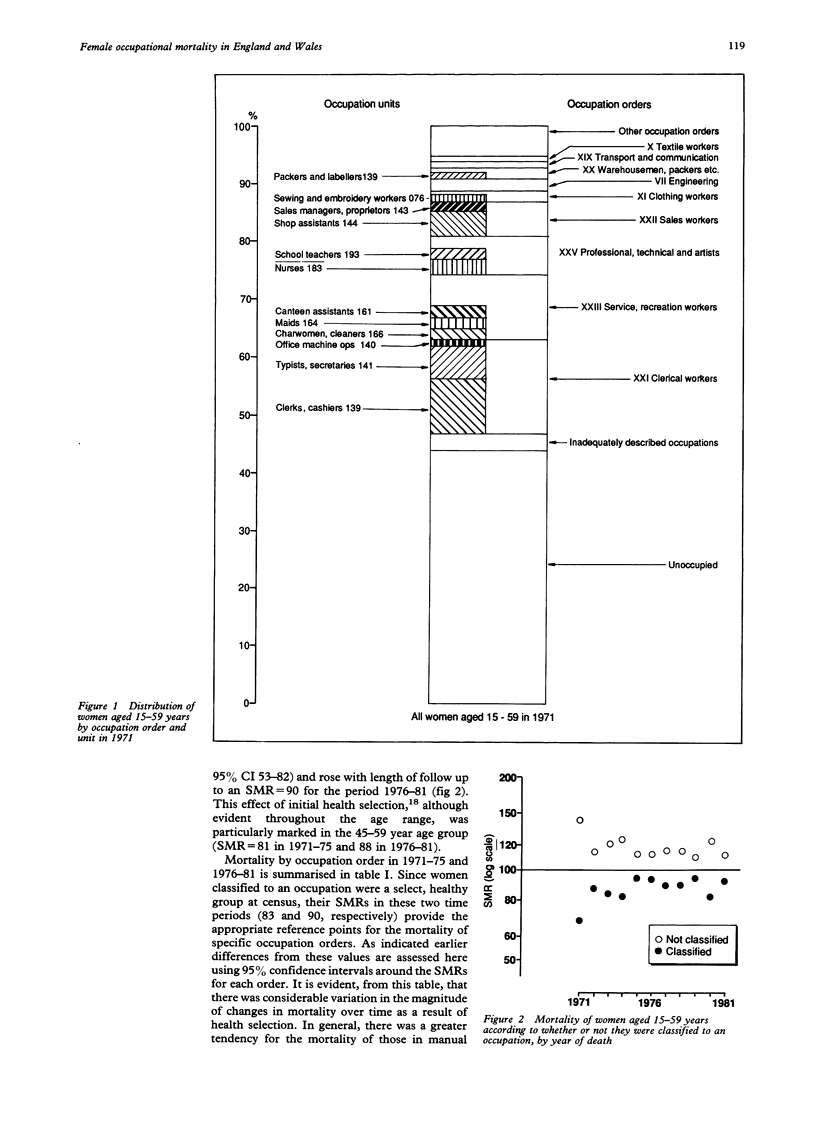


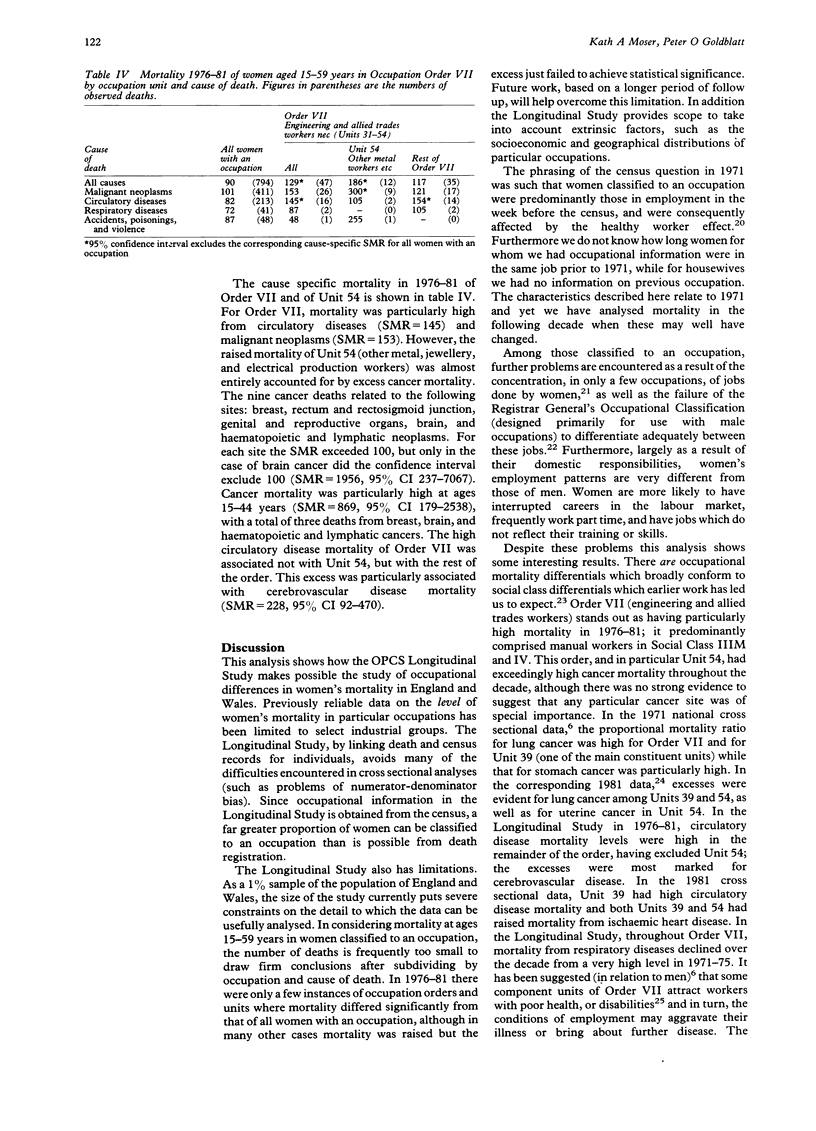
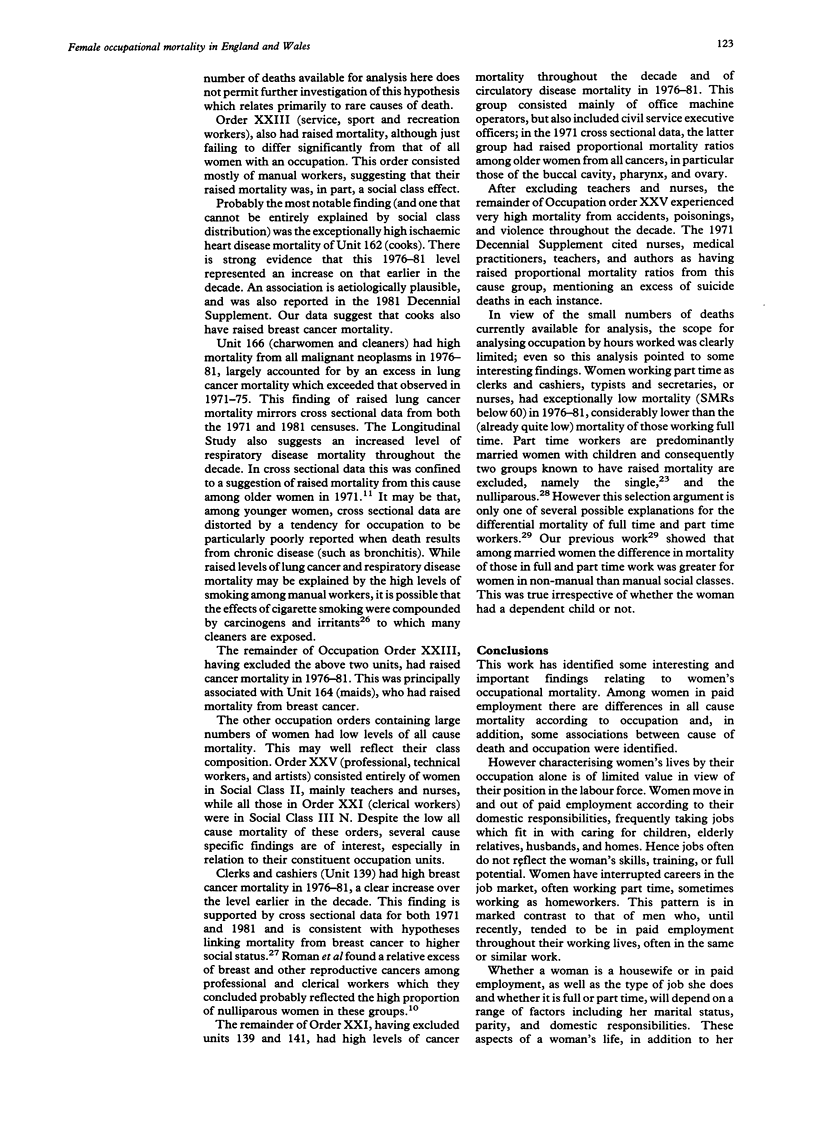

Selected References
These references are in PubMed. This may not be the complete list of references from this article.
- Berry G., Molyneux M. K., Tombleson J. B. Relationship between dust level and byssinoiss and bronchitis in Lancashire cotton mills. Br J Ind Med. 1974 Jan;31(1):18–27. doi: 10.1136/oem.31.1.18. [DOI] [PMC free article] [PubMed] [Google Scholar]
- Doll R., Gray R., Hafner B., Peto R. Mortality in relation to smoking: 22 years' observations on female British doctors. Br Med J. 1980 Apr 5;280(6219):967–971. doi: 10.1136/bmj.280.6219.967. [DOI] [PMC free article] [PubMed] [Google Scholar]
- Fox A. J., Collier P. F. Low mortality rates in industrial cohort studies due to selection for work and survival in the industry. Br J Prev Soc Med. 1976 Dec;30(4):225–230. doi: 10.1136/jech.30.4.225. [DOI] [PMC free article] [PubMed] [Google Scholar]
- Fox A. J., Collier P. F. Mortality experience of workers exposed to vinyl chloride monomer in the manufacture of polyvinyl chloride in Great Britain. Br J Ind Med. 1977 Feb;34(1):1–10. doi: 10.1136/oem.34.1.1. [DOI] [PMC free article] [PubMed] [Google Scholar]
- Fox A. J., Goldblatt P. O., Adelstein A. M. Selection and mortality differentials. J Epidemiol Community Health. 1982 Jun;36(2):69–79. doi: 10.1136/jech.36.2.69. [DOI] [PMC free article] [PubMed] [Google Scholar]
- Fraser P., Chilvers C., Goldblatt P. Census-based mortality study of fertiliser manufactures. Br J Ind Med. 1982 Nov;39(4):323–329. doi: 10.1136/oem.39.4.323. [DOI] [PMC free article] [PubMed] [Google Scholar]
- Green A., Beral V., Moser K. Mortality in women in relation to their childbearing history. BMJ. 1988 Aug 6;297(6645):391–395. doi: 10.1136/bmj.297.6645.391. [DOI] [PMC free article] [PubMed] [Google Scholar]
- Harrington J. M., Goldblatt P. Census based mortality study of pharmaceutical industry workers. Br J Ind Med. 1986 Mar;43(3):206–211. doi: 10.1136/oem.43.3.206. [DOI] [PMC free article] [PubMed] [Google Scholar]
- Moser K. A., Pugh H. S., Goldblatt P. O. Inequalities in women's health: looking at mortality differentials using an alternative approach. Br Med J (Clin Res Ed) 1988 Apr 30;296(6631):1221–1224. doi: 10.1136/bmj.296.6631.1221. [DOI] [PMC free article] [PubMed] [Google Scholar]
- Newhouse M. L., Berry G., Wagner J. C., Turok M. E. A study of the mortality of female asbestos workers. Br J Ind Med. 1972 Apr;29(2):134–141. doi: 10.1136/oem.29.2.134. [DOI] [PMC free article] [PubMed] [Google Scholar]
- Ostlin P. Negative health selection into physically light occupations. J Epidemiol Community Health. 1988 Jun;42(2):152–156. doi: 10.1136/jech.42.2.152. [DOI] [PMC free article] [PubMed] [Google Scholar]
- Roman E., Beral V., Inskip H. Occupational mortality among women in England and Wales. Br Med J (Clin Res Ed) 1985 Jul 20;291(6489):194–196. doi: 10.1136/bmj.291.6489.194. [DOI] [PMC free article] [PubMed] [Google Scholar]
- Wignall B. K., Fox A. J. Mortality of female gas mask assemblers. Br J Ind Med. 1982 Feb;39(1):34–38. doi: 10.1136/oem.39.1.34. [DOI] [PMC free article] [PubMed] [Google Scholar]


